July 12, 2021 Teddy Roosevelt N.P.
We continued our travels across North Dakota to the western edge of the state where we finally explored Theodore Roosevelt National Park. We’ve been wanting to visit for many years, and finally made it! We took the scenic drive in the North Unit of the park and enjoyed the vistas and wildlife residents!

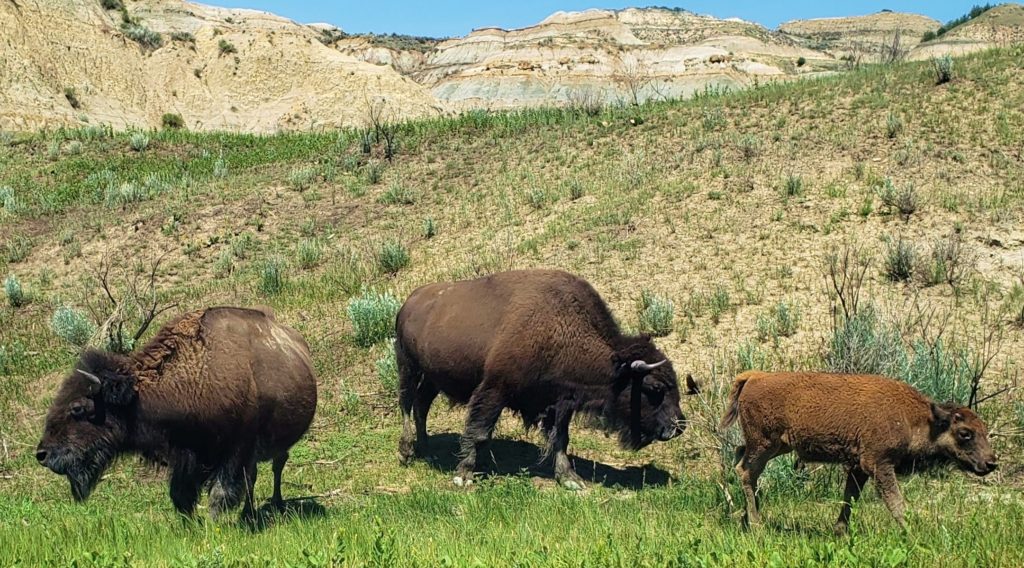
The bison herd slowed traffic as they walked across the road or rolled in the dust.
July 11, 2021 The Future?
 The Washburn, ND area has several coal-fired power plants. Is this our short-term future? We need to find solutions or it will indeed be a short-term future!
The Washburn, ND area has several coal-fired power plants. Is this our short-term future? We need to find solutions or it will indeed be a short-term future!
July 10, 2021 The (Relatively) Recent
The Awatixa Xi’e Village, pronounced (Ah-wah-TEE-khah)(Eh) is also known as Sakakawea Village. It was the home of Toussaint Charbonneau and two of his Shoshone wives(?), one known as Sacagawea, in 1804 when the Corps of Discovery overwintered in the area. We spent this afternoon exploring the replica Fort Mandan, the winter 1804-1805 camp of the Lewis & Clark Expedition. The exterior of the triangular fort is unassuming, but very defensive! The original was built in November 1804 in about 4 weeks using the abundant lumber found along the banks of the Missouri river.
The exterior of the triangular fort is unassuming, but very defensive! The original was built in November 1804 in about 4 weeks using the abundant lumber found along the banks of the Missouri river. The interior shows the triangular configuration. Work areas were on the left, like blacksmith and carpenter shops. Storage rooms were at the apex of the triangle. Lodging was in small cabins with stone fireplaces along the right wall.
The interior shows the triangular configuration. Work areas were on the left, like blacksmith and carpenter shops. Storage rooms were at the apex of the triangle. Lodging was in small cabins with stone fireplaces along the right wall.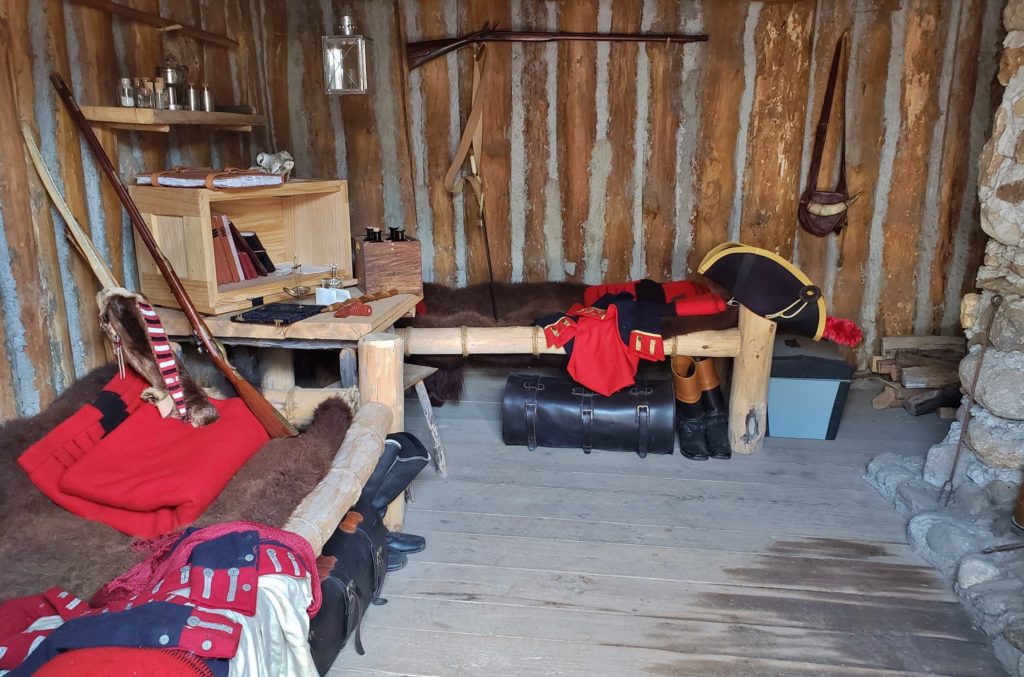 The expedition started out with 27 soldiers, 16 boat crew , 1 slave (York) and 1 French-Indian interpreter. They all participated in hunting and trapping, sewing clothes of leather, cooking, etc. One soldier had died in August, 1804 probably due to appendicitis, the only death of the whole expedition. The soldiers were housed in several cramped quarters like this.
The expedition started out with 27 soldiers, 16 boat crew , 1 slave (York) and 1 French-Indian interpreter. They all participated in hunting and trapping, sewing clothes of leather, cooking, etc. One soldier had died in August, 1804 probably due to appendicitis, the only death of the whole expedition. The soldiers were housed in several cramped quarters like this. Being an Expedition of Discovery, room was made for the equipment to create maps, record encounters with Natives and wildlife and prepare specimens to return to the United States proper.
Being an Expedition of Discovery, room was made for the equipment to create maps, record encounters with Natives and wildlife and prepare specimens to return to the United States proper. ‘Civilians’, the boat crew and interpreter, were housed separately and were joined by Charbonneau and Sacagawea. They were increased by one on the birth of their son, Jean-Baptiste, on February 11, 1805. In April, 1805 some of the contracted boat crew embarked downstream on the Missouri to return to the U.S. with collected specimens and maps. The bulk of the Corps started the arduous trek to the Pacific ocean. Sacagawea and her son were integral members of the expedition now, evidence to hostile Natives that this was not a war party, and interpreters when they encountered Sacagawea’s tribe and family members among the Shoshone. The expedition returned to the area in August of 1806 where Charbonneau and Sacagawea returned to their lives in Awatixa Xi’e Village.
‘Civilians’, the boat crew and interpreter, were housed separately and were joined by Charbonneau and Sacagawea. They were increased by one on the birth of their son, Jean-Baptiste, on February 11, 1805. In April, 1805 some of the contracted boat crew embarked downstream on the Missouri to return to the U.S. with collected specimens and maps. The bulk of the Corps started the arduous trek to the Pacific ocean. Sacagawea and her son were integral members of the expedition now, evidence to hostile Natives that this was not a war party, and interpreters when they encountered Sacagawea’s tribe and family members among the Shoshone. The expedition returned to the area in August of 1806 where Charbonneau and Sacagawea returned to their lives in Awatixa Xi’e Village.
July 10, 2021 The Ancient
Nearby Washburn, ND is the National Historic Site known as the Knife River Indian Villages. These villages were hubs of commerce; trading crops and wild game, horses, beads, other handiwork and especially prized Knife river flint with other tribes as far as the gulf coast and the pacific northwest. We visited early this morning before it got too hot to be out in the unrelenting sunshine.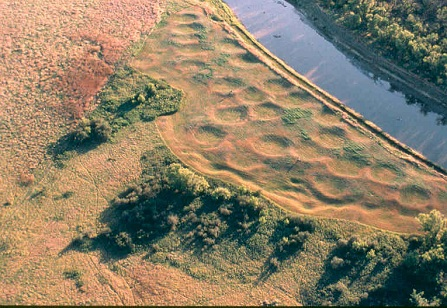 This aerial view shows the circular depressions marking the earth lodges of Awatixa Xi’e Village, also known as the Lower Hidatsa Village. It is believed to have been established around 1525 and continuously occupied until smallpox epidemics between 1780 to 1785 emptied the village. The Awatixa subgrooup of the Hidatsa returned to the area around 1790 to reestablish the village. Depressions in the earth of about 50 lodges, housing an estimated 500-600 inhabitants, are all that remain.
This aerial view shows the circular depressions marking the earth lodges of Awatixa Xi’e Village, also known as the Lower Hidatsa Village. It is believed to have been established around 1525 and continuously occupied until smallpox epidemics between 1780 to 1785 emptied the village. The Awatixa subgrooup of the Hidatsa returned to the area around 1790 to reestablish the village. Depressions in the earth of about 50 lodges, housing an estimated 500-600 inhabitants, are all that remain. A full scale reconstruction of an earthlodge is available to explore, as well as a native garden where corn, squash and beans (the three sisters combination) as well as melons and sunflowers are grown.
A full scale reconstruction of an earthlodge is available to explore, as well as a native garden where corn, squash and beans (the three sisters combination) as well as melons and sunflowers are grown.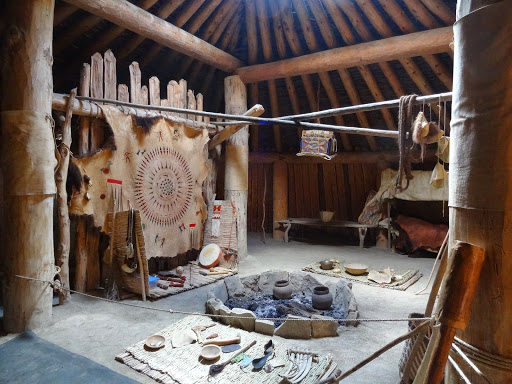 The interior of the lodge was roomy enough for 10-30 people of one or more families, dogs and a few prized horses, tied to a hitching post behind the decorative painted hide, to the side of the doorway vestibule.
The interior of the lodge was roomy enough for 10-30 people of one or more families, dogs and a few prized horses, tied to a hitching post behind the decorative painted hide, to the side of the doorway vestibule. A close up of the hide, a replica of the Mato-Tope, or Four Bears Exploit Robe. History of the robe can be seen here.
A close up of the hide, a replica of the Mato-Tope, or Four Bears Exploit Robe. History of the robe can be seen here.  On our walk around the quiet, green, peaceful grounds we found this owl feather (some believe owl feathers represent truth and knowledge). We left it for others to discover.
On our walk around the quiet, green, peaceful grounds we found this owl feather (some believe owl feathers represent truth and knowledge). We left it for others to discover.



 The Washburn, ND area has several coal-fired power plants. Is this our short-term future? We need to find solutions or it will indeed be a short-term future!
The Washburn, ND area has several coal-fired power plants. Is this our short-term future? We need to find solutions or it will indeed be a short-term future! The exterior of the triangular fort is unassuming, but very defensive! The original was built in November 1804 in about 4 weeks using the abundant lumber found along the banks of the Missouri river.
The exterior of the triangular fort is unassuming, but very defensive! The original was built in November 1804 in about 4 weeks using the abundant lumber found along the banks of the Missouri river. The interior shows the triangular configuration. Work areas were on the left, like blacksmith and carpenter shops. Storage rooms were at the apex of the triangle. Lodging was in small cabins with stone fireplaces along the right wall.
The interior shows the triangular configuration. Work areas were on the left, like blacksmith and carpenter shops. Storage rooms were at the apex of the triangle. Lodging was in small cabins with stone fireplaces along the right wall. The expedition started out with 27 soldiers, 16 boat crew , 1 slave (York) and 1 French-Indian interpreter. They all participated in hunting and trapping, sewing clothes of leather, cooking, etc. One soldier had died in August, 1804 probably due to appendicitis, the only death of the whole expedition. The soldiers were housed in several cramped quarters like this.
The expedition started out with 27 soldiers, 16 boat crew , 1 slave (York) and 1 French-Indian interpreter. They all participated in hunting and trapping, sewing clothes of leather, cooking, etc. One soldier had died in August, 1804 probably due to appendicitis, the only death of the whole expedition. The soldiers were housed in several cramped quarters like this. Being an Expedition of Discovery, room was made for the equipment to create maps, record encounters with Natives and wildlife and prepare specimens to return to the United States proper.
Being an Expedition of Discovery, room was made for the equipment to create maps, record encounters with Natives and wildlife and prepare specimens to return to the United States proper. ‘Civilians’, the boat crew and interpreter, were housed separately and were joined by Charbonneau and Sacagawea. They were increased by one on the birth of their son, Jean-Baptiste, on February 11, 1805. In April, 1805 some of the contracted boat crew embarked downstream on the Missouri to return to the U.S. with collected specimens and maps. The bulk of the Corps started the arduous trek to the Pacific ocean. Sacagawea and her son were integral members of the expedition now, evidence to hostile Natives that this was not a war party, and interpreters when they encountered Sacagawea’s tribe and family members among the Shoshone. The expedition returned to the area in August of 1806 where Charbonneau and Sacagawea returned to their lives in Awatixa Xi’e Village.
‘Civilians’, the boat crew and interpreter, were housed separately and were joined by Charbonneau and Sacagawea. They were increased by one on the birth of their son, Jean-Baptiste, on February 11, 1805. In April, 1805 some of the contracted boat crew embarked downstream on the Missouri to return to the U.S. with collected specimens and maps. The bulk of the Corps started the arduous trek to the Pacific ocean. Sacagawea and her son were integral members of the expedition now, evidence to hostile Natives that this was not a war party, and interpreters when they encountered Sacagawea’s tribe and family members among the Shoshone. The expedition returned to the area in August of 1806 where Charbonneau and Sacagawea returned to their lives in Awatixa Xi’e Village. This aerial view shows the circular depressions marking the earth lodges of Awatixa Xi’e Village, also known as the Lower Hidatsa Village. It is believed to have been established around 1525 and continuously occupied until smallpox epidemics between 1780 to 1785 emptied the village. The Awatixa subgrooup of the Hidatsa returned to the area around 1790 to reestablish the village. Depressions in the earth of about 50 lodges, housing an estimated 500-600 inhabitants, are all that remain.
This aerial view shows the circular depressions marking the earth lodges of Awatixa Xi’e Village, also known as the Lower Hidatsa Village. It is believed to have been established around 1525 and continuously occupied until smallpox epidemics between 1780 to 1785 emptied the village. The Awatixa subgrooup of the Hidatsa returned to the area around 1790 to reestablish the village. Depressions in the earth of about 50 lodges, housing an estimated 500-600 inhabitants, are all that remain. A full scale reconstruction of an earthlodge is available to explore, as well as a native garden where corn, squash and beans (the three sisters combination) as well as melons and sunflowers are grown.
A full scale reconstruction of an earthlodge is available to explore, as well as a native garden where corn, squash and beans (the three sisters combination) as well as melons and sunflowers are grown. The interior of the lodge was roomy enough for 10-30 people of one or more families, dogs and a few prized horses, tied to a hitching post behind the decorative painted hide, to the side of the doorway vestibule.
The interior of the lodge was roomy enough for 10-30 people of one or more families, dogs and a few prized horses, tied to a hitching post behind the decorative painted hide, to the side of the doorway vestibule. A close up of the hide, a replica of the Mato-Tope, or Four Bears Exploit Robe. History of the robe can be seen
A close up of the hide, a replica of the Mato-Tope, or Four Bears Exploit Robe. History of the robe can be seen  On our walk around the quiet, green, peaceful grounds we found this owl feather (some believe owl feathers represent truth and knowledge). We left it for others to discover.
On our walk around the quiet, green, peaceful grounds we found this owl feather (some believe owl feathers represent truth and knowledge). We left it for others to discover. The Railway and grain elevator blocked our view of the river! But at least we had a rolling art gallery pass by!
The Railway and grain elevator blocked our view of the river! But at least we had a rolling art gallery pass by!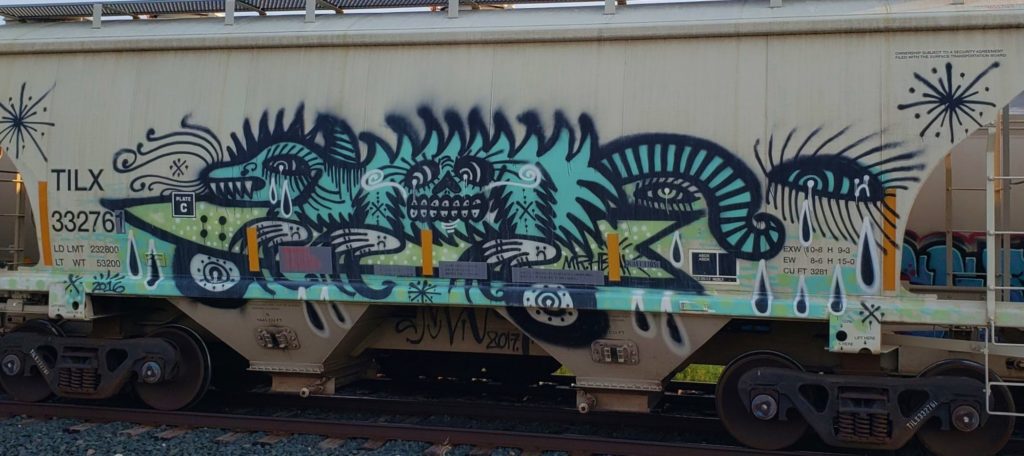 Once past the railroad tracks we had a great walkway along the river.
Once past the railroad tracks we had a great walkway along the river.